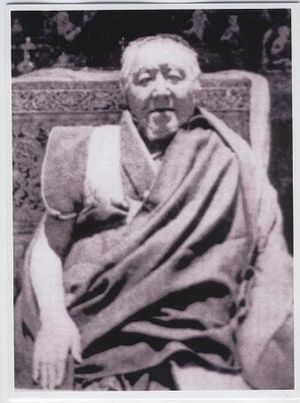Ngawang Tenzin Norbu: Difference between revisions
No edit summary |
Yeshedorje (talk | contribs) mNo edit summary |
||
| (10 intermediate revisions by 4 users not shown) | |||
| Line 1: | Line 1: | ||
[[Image:NgawangTenzinNorbu.JPG| | [[Image:NgawangTenzinNorbu.JPG|thumb|Ngawang Tenzin Norbu]] | ||
'''Ngawang Tenzin Norbu''' ([[Wyl.]] ''ngag dbang bstan 'dzin nor bu'') (1867-1940/42) | '''Ngawang Tenzin Norbu''' (Tib. ངག་དབང་བསྟན་འཛིན་ནོར་བུ་, [[Wyl.]] ''ngag dbang bstan 'dzin nor bu''), aka the '''10th Dzatrul Rinpoche''' (1867-1940/42), who was one of the main teachers of Kyabjé [[Trulshik Rinpoche]], is remembered especially for his commentaries on the ''[[Thirty-Seven Practices of the Bodhisattvas]]''. One of the foremost disciples of [[Trulshik Dongak Lingpa]], he became known as the Buddha of Dza Rongphu (རྫ་རོང་ཕུ་, Wyl. ''rdza rong phu'') after his place of residence in the upper valley of the Dzakar River, which became known as [[Rongpuk Monastery]]. It was there that he undertook retreat and founded the monastery of Dongak Zungjuk Ling in 1901<ref>Ngawang Shedrub Tenpe Gyaltsen Rinpoche & Ven. Jamyang Wangmo, ''Dharma Wheel of Great Bliss'' (Kathmandu: Vajra Publications, 2008) p.27</ref> on the northern slopes of [[Mount Everest]]. He also studied for many years at [[Mindroling Monastery]]. | ||
In 1922 Ngawang Tenzin Norbu met a group of climbers led by General C. G. Bruce and later wrote about the encounter in his autobiography. | In 1922 Ngawang Tenzin Norbu met a group of climbers led by General C. G. Bruce and later wrote about the encounter in his autobiography.<ref>See Macdonald 1973</ref> | ||
After he passed away his body was enshrined in a case made of ''akaro'' wood. It was later brought out of Tibet by Trulshik Rinpoche and the monks of Dza Rongphu as they fled in 1959. The body was cremated at Thangmé Monastery in the Solu Khumbu region of Nepal.<ref>Ngawang Shedrub Tenpe Gyaltsen Rinpoche & Ven. Jamyang Wangmo, ''Dharma Wheel of Great Bliss'' (Kathmandu: Vajra Publications, 2008) p.30</ref> | |||
==Writings== | |||
*''rgyal sras lag len so bdun gyi 'grel pa gzhung dang gdams ngag zung 'jug bdud rtsi'i bum bzang'' (Dharamsala: LTWA, 2006) | |||
:{{TBRC|W00EGS1016772|༈ རྒྱལ་སྲས་ལག་ལེན་སོ་བདུན་གྱི་འགྲེལ་པ་གཞུང་དང་གདམས་ངག་ཟུང་འཇུག་བདུད་རྩིའི་བུམ་བཟང།}} | |||
==Notes== | |||
<small><references/></small> | |||
==Further Reading== | ==Further Reading== | ||
*Aziz, Barbara Nimri. ''Tibetan Frontier Families: Reflections of three generations from Ding-ri'', Carolina Academic Press, 1978 | |||
*[[Dilgo Khyentse Rinpoche|Dilgo Khyentse]], ''The Heart of Compassion: The Thirty-seven Verses on the Practice of a Bodhisattva'', translated by Padmakara Translation Group, Shambhala, 2007 | *[[Dilgo Khyentse Rinpoche|Dilgo Khyentse]], ''The Heart of Compassion: The Thirty-seven Verses on the Practice of a Bodhisattva'', translated by Padmakara Translation Group, Shambhala, 2007 | ||
* | *Macdonald, A. W. 'The Lama and the General', ''Kailash'', I, no. 3, 1973, pp. 225-233. | ||
*Wangmo, Jamyang. ''The Lawudo Lama, Stories of Reincarnation from the Mount Everest Region'', Wisdom Publications, 2005 | |||
* | |||
==Internal Links== | |||
*[[Dzatrul Rinpoche]] | |||
*[[Khembalung]] | |||
*[[Lord of the Dance]] | |||
*[[Miyo Lang Zangma]] | |||
*[[Rongpuk Monastery]] | |||
*[[Tengboche Monastery]] | |||
*[[Tengboche Rinpoche]] | |||
*[[Thupten Chöling]] | |||
*[[Yangti Nakpo]] | |||
==External Links== | ==External Links== | ||
* | *{{LH|topics/refuge/commentary-ngawang-tenzin-norbu|''A Brief Commentary on the Refuge & Bodhichitta Prayer known as Sangyé Chö Tsok Ma'' by Ngawang Tenzin Norbu}} | ||
* | *{{TBRC|P708|TBRC Profile}} | ||
[[Category:Nyingma Masters]] | [[Category:Nyingma Masters]] | ||
[[Category:Historical Masters]] | [[Category:Historical Masters]] | ||
Latest revision as of 07:48, 31 March 2020

Ngawang Tenzin Norbu (Tib. ངག་དབང་བསྟན་འཛིན་ནོར་བུ་, Wyl. ngag dbang bstan 'dzin nor bu), aka the 10th Dzatrul Rinpoche (1867-1940/42), who was one of the main teachers of Kyabjé Trulshik Rinpoche, is remembered especially for his commentaries on the Thirty-Seven Practices of the Bodhisattvas. One of the foremost disciples of Trulshik Dongak Lingpa, he became known as the Buddha of Dza Rongphu (རྫ་རོང་ཕུ་, Wyl. rdza rong phu) after his place of residence in the upper valley of the Dzakar River, which became known as Rongpuk Monastery. It was there that he undertook retreat and founded the monastery of Dongak Zungjuk Ling in 1901[1] on the northern slopes of Mount Everest. He also studied for many years at Mindroling Monastery.
In 1922 Ngawang Tenzin Norbu met a group of climbers led by General C. G. Bruce and later wrote about the encounter in his autobiography.[2]
After he passed away his body was enshrined in a case made of akaro wood. It was later brought out of Tibet by Trulshik Rinpoche and the monks of Dza Rongphu as they fled in 1959. The body was cremated at Thangmé Monastery in the Solu Khumbu region of Nepal.[3]
Writings
- rgyal sras lag len so bdun gyi 'grel pa gzhung dang gdams ngag zung 'jug bdud rtsi'i bum bzang (Dharamsala: LTWA, 2006)
Notes
Further Reading
- Aziz, Barbara Nimri. Tibetan Frontier Families: Reflections of three generations from Ding-ri, Carolina Academic Press, 1978
- Dilgo Khyentse, The Heart of Compassion: The Thirty-seven Verses on the Practice of a Bodhisattva, translated by Padmakara Translation Group, Shambhala, 2007
- Macdonald, A. W. 'The Lama and the General', Kailash, I, no. 3, 1973, pp. 225-233.
- Wangmo, Jamyang. The Lawudo Lama, Stories of Reincarnation from the Mount Everest Region, Wisdom Publications, 2005
Internal Links
- Dzatrul Rinpoche
- Khembalung
- Lord of the Dance
- Miyo Lang Zangma
- Rongpuk Monastery
- Tengboche Monastery
- Tengboche Rinpoche
- Thupten Chöling
- Yangti Nakpo